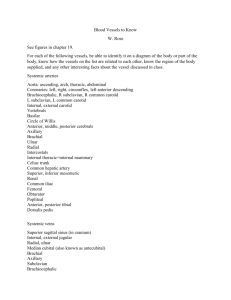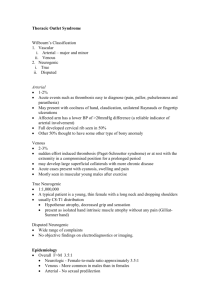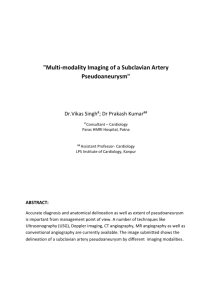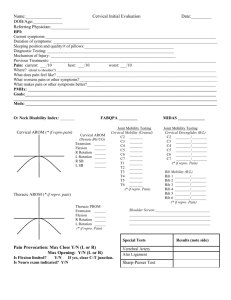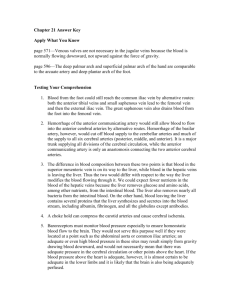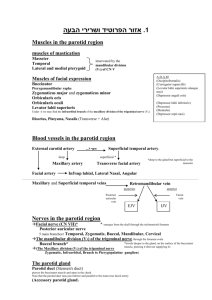A Woman With Acute Dilated Veins Over the Anterior Chest Wall
advertisement
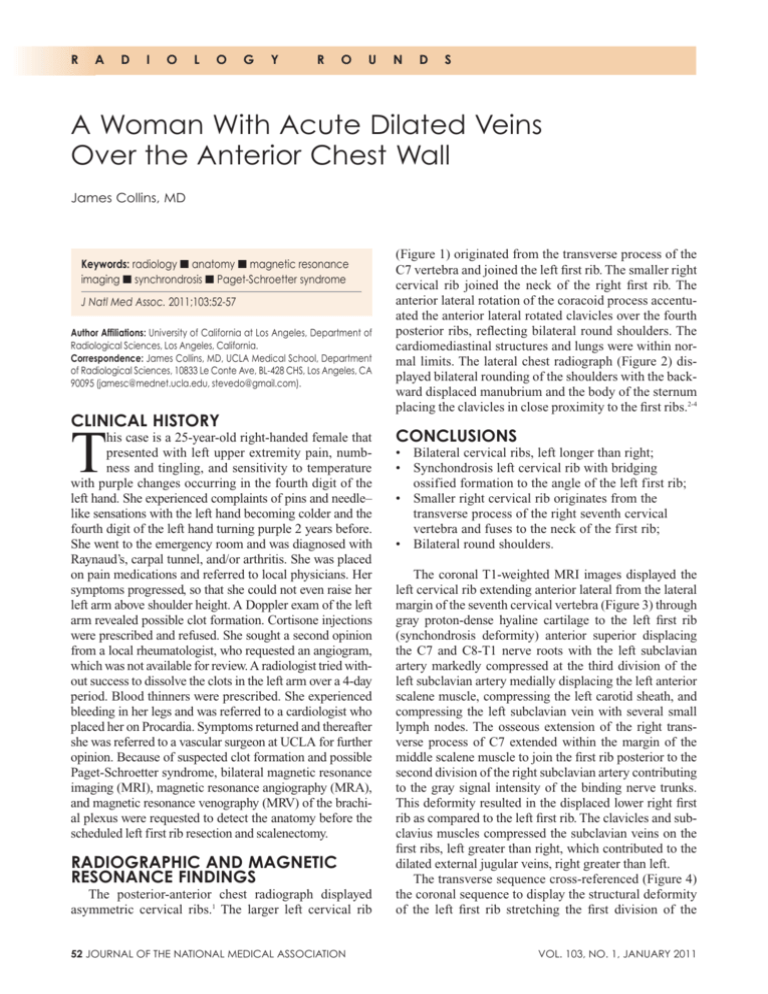
r a d i o l o g y r o u n d s A Woman With Acute Dilated Veins Over the Anterior Chest Wall James Collins, MD Keywords: radiology n anatomy n magnetic resonance imaging n synchrondrosis n Paget-Schroetter syndrome J Natl Med Assoc. 2011;103:52-57 Author Affiliations: University of California at Los Angeles, Department of Radiological Sciences, Los Angeles, California. Correspondence: James Collins, MD, UCLA Medical School, Department of Radiological Sciences, 10833 Le Conte Ave, BL-428 CHS, Los Angeles, CA 90095 (jamesc@mednet.ucla.edu, stevedo@gmail.com). CLINICAL HISTORY T his case is a 25-year-old right-handed female that presented with left upper extremity pain, numbness and tingling, and sensitivity to temperature with purple changes occurring in the fourth digit of the left hand. She experienced complaints of pins and needle– like sensations with the left hand becoming colder and the fourth digit of the left hand turning purple 2 years before. She went to the emergency room and was diagnosed with Raynaud’s, carpal tunnel, and/or arthritis. She was placed on pain medications and referred to local physicians. Her symptoms progressed, so that she could not even raise her left arm above shoulder height. A Doppler exam of the left arm revealed possible clot formation. Cortisone injections were prescribed and refused. She sought a second opinion from a local rheumatologist, who requested an angiogram, which was not available for review. A radiologist tried without success to dissolve the clots in the left arm over a 4-day period. Blood thinners were prescribed. She experienced bleeding in her legs and was referred to a cardiologist who placed her on Procardia. Symptoms returned and thereafter she was referred to a vascular surgeon at UCLA for further opinion. Because of suspected clot formation and possible Paget-Schroetter syndrome, bilateral magnetic resonance imaging (MRI), magnetic resonance angiography (MRA), and magnetic resonance venography (MRV) of the brachial plexus were requested to detect the anatomy before the scheduled left first rib resection and scalenectomy. RADIOGRAPHIC AND Magnetic Resonance FINDINGS The posterior-anterior chest radiograph displayed asymmetric cervical ribs.1 The larger left cervical rib 52 JOURNAL OF THE NATIONAL MEDICAL ASSOCIATION (Figure 1) originated from the transverse process of the C7 vertebra and joined the left first rib. The smaller right cervical rib joined the neck of the right first rib. The anterior lateral rotation of the coracoid process accentuated the anterior lateral rotated clavicles over the fourth posterior ribs, reflecting bilateral round shoulders. The cardiomediastinal structures and lungs were within normal limits. The lateral chest radiograph (Figure 2) displayed bilateral rounding of the shoulders with the backward displaced manubrium and the body of the sternum placing the clavicles in close proximity to the first ribs.2-4 CONCLUSIONS • Bilateral cervical ribs, left longer than right; • Synchondrosis left cervical rib with bridging ossified formation to the angle of the left first rib; • Smaller right cervical rib originates from the transverse process of the right seventh cervical vertebra and fuses to the neck of the first rib; • Bilateral round shoulders. The coronal T1-weighted MRI images displayed the left cervical rib extending anterior lateral from the lateral margin of the seventh cervical vertebra (Figure 3) through gray proton-dense hyaline cartilage to the left first rib (synchondrosis deformity) anterior superior displacing the C7 and C8-T1 nerve roots with the left subclavian artery markedly compressed at the third division of the left subclavian artery medially displacing the left anterior scalene muscle, compressing the left carotid sheath, and compressing the left subclavian vein with several small lymph nodes. The osseous extension of the right transverse process of C7 extended within the margin of the middle scalene muscle to join the first rib posterior to the second division of the right subclavian artery contributing to the gray signal intensity of the binding nerve trunks. This deformity resulted in the displaced lower right first rib as compared to the left first rib. The clavicles and subclavius muscles compressed the subclavian veins on the first ribs, left greater than right, which contributed to the dilated external jugular veins, right greater than left. The transverse sequence cross-referenced (Figure 4) the coronal sequence to display the structural deformity of the left first rib stretching the first division of the VOL. 103, NO. 1, JANUARY 2011 Acute Dilated Veins Over the Anterior Chest Wall small left subclavian artery as it entered the scalene triangle with binding nerve roots displacing the compressed subclavian artery against the anterior scalene muscle dilating the transverse cervical artery, and the junction of the left external jugular and subclavian veins. The marked narrowing of the intermediate gray signal intensity of the left internal vein superiorly reflected the compression by the left sternocleidomastoid muscle decreasing venous return. The right cervical rib takes origin from the transverse process of the seventh cervical vertebrae and ends within the right middle scalene muscle. The transverse (Figure 4) and sagittal sequences (Figure 5) cross-referenced the above findings. The two-dimensional time-of-flight stacked image and three-dimensional reconstructed coronal images confirmed the above. The high signal intensity of the left subclavian vein and anterior bowing of the high protondense left external jugular and transverse cervical veins reflected impedance to venous return by the structural deformity of the left cervical and first ribs (synchondrosis deformity) compression (Figure 6). The diminished signal intensity of the left axillary vein reflected diminished venous return with compensatory dilatation of the left vertebral vein marginating the left vertebral artery. The diminished signal intensity of the markedly narrowed left internal jugular and right internal jugular veins superior to the subclavian vein reflected bilateral sternocleidomastoid muscle compression. The narrowed segment of the right subclavian vein reflected mild costoclavicular compression. The coronal bilateral abduction and external rotation (AER) sequence compressed the left subclavian artery and subclavian vein on the structurally deformed first rib. High signal intensity in hepatic and internal thoracic veins reflected decreased venous return. Bilateral AER of the upper extremities captured images that displayed the posterior inferior rotation of the clavicles and subclavius muscles with posterior anterior medial rotation of the coracoid processes compressing the left subclavian artery with binding nerve trunks and left subclavian vein on the structurally deformed first rib. The marked dilated left axillary vein and the postenotic dilated axillary artery were displayed as compared to the right. High signal intensity hepatic and internal thoracic veins reflected decreased venous return. Bilateral AER of the upper extremities triggered complaints only on the left. Immediate pain was experienced over the left deltoid muscle, axilla, neck, and pain Figure 1. Chest views A, Posterior-anterior enlarged view of the chest that displays the asymmetric cervical ribs (CR). The larger left cervical rib (CR) originated from the transverse process of the C7 vertebra joining the left first rib (FR). The smaller right cervical rib (CR) joined the neck of the right first rib (FR). The anterior lateral rotation of the coracoid processes (not labeled) accentuated the anterior lateral rotated clavicles (C) over the fourth posterior ribs (not labeled) reflecting bilateral round shoulders. The cardiomediastinal structures and lungs were within normal limits. A indicates aorta (A); P, pulmonary artery; LL and RL, left and right lungs; 5R, fifth posterior rib; X, synchondrosis deformity cervical ribs to the first rib, left greater than right; 4, 5, 6, 7, cervical vertebrae; first thoracic vertebra (1T) and L as a marker. B, Graphic display of the enlarged posterior-anterior chest radiograph as shown in A. Observe the asymmetric left and right cervical ribs (CR) and the hyaline cartilage (X) fused to the left first rib (X). Region of the A indicates aorta; C, clavicle; 7, cervical vertebrae; FR, first ribs; 5R, fifth ribs; LL, RL, left and right lungs; P, pulmonary artery; 1T-4T, thoracic vertebrae; TX, transverse processes. JOURNAL OF THE NATIONAL MEDICAL ASSOCIATION VOL. 103, NO. 1, JANUARY 2011 53 Acute Dilated Veins Over the Anterior Chest Wall down into the 4 to 5 digits of the left hand. The whole arm and hand were numb and discolored. Left hip pain radiated down into all toes of the left foot, followed by tingling and numbness of the left and foot. Headache developed over the left frontal region with nausea and a dizzy-like sensation. LABORATORY RESULTS CONCLUSIONs • Thoracic outlet compression of subclavian artery on the left with cervical rib; • Distal embolization; • Ischemia left upper extremity, and postoperative diagnosis was the same. • Bilateral round shoulders; • Bilateral cervical ribs, left longer than right; • Synchondrosis deformity of the left cervical rib and first rib compressing the left scalene triangle, subclavian vein, and artery; • Atrophic left internal jugular vein; • Compressed right internal jugular vein as described; • Reactive fibrosis left structurally deformed first rib and subclavian artery and binding nerve trunks. PHYSICAL EXAMINATION Blood pressure in the right arm was 120/70 mm Hg; in the left arm, 90/60 mm Hg. The patient’s height was 158 m and weight 62.2 kg. The left arm was mildly edematous and dusty in color. Figure 2. Lateral chest view displays bilateral rounding of the shoulders (X), backward displaced manubrium (M), with the body of the sternum (S) placing the clavicles (not labeled) in close proximity to first ribs H indicates heart; T, trachea; 6T, sixth thoracic vertebra. 54 JOURNAL OF THE NATIONAL MEDICAL ASSOCIATION The patient’s blood type was O Rh-negative and complete blood count was normal. Chemistries were within normal range. Prothrombin time panel and prothrombin time were within normal range. DIAGNOSIS She was taken to the surgical suite with the preoperative diagnoses. The operation title(s) were: (1) transaxillary resection of left first and cervical ribs; (2) neurolysis, lower cords of brachial plexus attached to the cervical rib; and (3) left chest thoracostomy. Operative Findings The patient underwent left transaxillary first rib and cervical rib resection that displayed the lower cord of the plexus markedly adherent to the cervical rib and required neurolysis. The pleura was entered during resection of the posterior left first rib, requiring placement of a chest tube. The subclavian artery was compressed over the left cervical rib. After adequate endotracheal anesthesia, she was changed to a right lateral decubitus position. In the supine position, the left upper extremity, axilla, and left chest were prepped with betadine and draped with sterile drapes. An arm-holder device was utilized and then released during the case at intervals to avoid undue traction on the brachial plexus. A small incision below the axillary hairline on the left side was carried out through the skin and subcutaneous tissue. The intercostal brachial nerve was identified and preserved. Dissection was then carried out along the chest wall until the first rib was identified. Insertion of the anterior scalene muscle was divided with the cautery. The subclavian vein and artery were visualized, particularly the markedly compressed left subclavian artery by the cervical rib. Dissection was carried out along the cervical rib, protecting the lower cord of the plexus and medially dividing the insertion of the subclavius muscle. The subclavian vein and subclavian artery were then separated from the first rib. Dissection then continued along the border of the left first rib, identifying the junction of the first rib and the cervical rib. The first rib was elevated, trying to maintain its periosteum, and it was transected as far back as possible close to the transverse process. The middle scalene muscle was detached from the rib. The cervical rib was then transected medially to the costochondral junction of the sternum and removed. At this point, a tear occurred in the posterior pleura. It was large enough that approximation was not feasible. The area of the cervical rib and the lower cord of the plexus were VOL. 103, NO. 1, JANUARY 2011 Acute Dilated Veins Over the Anterior Chest Wall markedly adherent, requiring neurolysis of this structure, and retraction cephalad so that with a rongeur and the Roos nerve retractor and protector the cervical rib was taken down as far as possible with the rongeur. Several small segments were removed. Once this was completed, one could see the cord of the plexus free of any compression as well as the subclavian artery. The area was irrigated with antibiotic solution. A No. 28 chest tube was inserted through the fifth intercostal space connected to a Pleur-evac and secured at the skin level with a 2-0 silk stitch. Approximating the subcutaneous tissue with 3-0 PDS suture and the skin with a subcuticular 4-0 Monocryl suture then closed the axillary incision. A sterile dressing was applied. The patient was turned over supine to perform the left subclavian angioplasty with the Hemashield patch. She returned to the floor. Postoperative course was significant for a high output of material out of the chest tube. The patient’s chest output, however, was diminished over the subsequent days, and the patient was advanced in terms of diet and ambulatory activity and stable for discharge. Postoperative diagnosis was the same as above. DISCUSSION Synchondrosis is a kind of cartilaginous joint, usually temporary, where the intervening hyaline cartilage ordinarily is converted into bone before adult life. Synchondrosis deformities of a cervical or first rib are often displayed on posterior anterior chest radiographs and overlooked. Synchondrosis of the cervical and first ribs causes costoclavicular compression of the subclavian artery and binding nerve roots, draining veins within the neck and supraclavicular fossae. Paget-Schroetter syndrome is acute venous thrombosis of the compressed subclavian vein that disables young otherwise-healthy patients with thoracic outlet syndrome and migraine headache. These patients are thin, muscular with narrowed fascial planes. They all have very little subcutaneous fat. They all have one thing in common—inactivity—predisposing them to laxity of the shoulder girdle, venous stasis, sudden onset of pain, swelling, discoloration of the upper extremity, and collateral venous drainage over the chest wall.5,6 Round shoulder deformities with laxity of the sling/erector muscles (trapezius, levator scapulae, and the serratus anterior) of shoulders cause Figure 3. Coronal T1-weighted image that displays the synchondrosis deformity displacing the left subclavian artery (SA) with binding nerve roots with the elevated C7 nerve trunk A, aorta; AS, anterior scalene muscle; BR, brachiocephalic artery; C, clavicle; CC, right common carotid artery; AXV, axillary veins; CP, costoclavicular processes; E, esophagus; FR, first rib; M, middle cord; P, pulmonary artery; LL, RL, left and right lungs; STM, sternocleidomastoid muscles; 3, 5, cervical vertebrae; X, bar defect. JOURNAL OF THE NATIONAL MEDICAL ASSOCIATION VOL. 103, NO. 1, JANUARY 2011 55 Acute Dilated Veins Over the Anterior Chest Wall the forward shift of the C7-T3 cervicothoracic vertebrae contributing to kyphosis of the thoracic spine and round shoulders. The first ribs move forward and the manubrium and the heads of the clavicles with the subclavius and sternocleidomastoid muscles move backward compressing (costoclavicular compression) the bicuspid valves in the internal jugular and subclavian veins against the anterior scalene muscles, which compress the neurovascular bundles on the first rib(s).7 The coracoid processes rotate posterior-anterior medially reflecting the anterior-lateral rotation of the sagging scapulae and the pull of the pectoralis major, pectoralis minor, and subclavius muscles. This increases tension on those structures that cross the first ribs causing the lower trunk of the brachial plexus and the subclavian artery to move forward. This increases the pressure on these structures as they angulate around the posterior border of the anterior scalene muscle. The inferior trunk (C8-T1) is displaced forward against the firm-free posterior margin of the suprapleural fascia (Sibson’s fascia) resulting in acute compression of the neurovascular bundle. Bilateral AER of the upper extremities (arms overhead) in the clinical setting causes the clavicles with the subclavius muscles to rotate posterior inferiorly and the coracoid processes to rotated posterior-anterior medially, which enhances costoclavicular compression of the draining veins within the neck; supraclavicular fossae with the lymphatics; and compression of the neurovascular bundles, which triggers patient complaints. The referring vascular surgeon was very familiar with the symptoms of thoracic outlet syndrome. He initially considered left first rib resection and scalenectomy until he reviewed the MRI, MRA, and MRV as above described. Thereafter, he planned to replace the damaged segment of the left subclavian artery. This presentation is unable to display the entire Figure 5. Left sagittal T1-weighted image (28 of the series) that displays the left cervical rib (CR) and the synchondrosis deformity (BD) compressing the gray proton-dense left subclavian artery (SA) Figure 4. Transverse T1-weighted image that displays the synchondrosis bridging defect (BD) with the hyaline cartilage compressing the low signal intensity left subclavian artery (not labeled) anterior lateral to the left C8-T1 nerve trunks The small left internal jugular vein (J) is in close proximity to the left sternocleidomastoid muscle (not labeled). The backward second division of the right subclavian artery (SA) with binding nerve trunks (not labeled) hooks posterior to the dominant right anterior scalene muscle (AS). C, clavicle; CC, common carotid arteries; E, esophagus; FR, first rib; FSA, first fascicle of serratus muscle; LL, RL, left and right lungs; OM, omohyoid muscle; RH, rhomboid muscle; SPC, spinal cord; SUB, subclavius muscle; TRP, trapezius muscle; VV, vertebral veins; XJ, external jugular vein; 1T, first thoracic vertebra. 56 JOURNAL OF THE NATIONAL MEDICAL ASSOCIATION AS, anterior scalene muscle; C, clavicle; EJ, external jugular vein; FR, first rib; LL, left lung; SR, second rib; SV, subclavian vein; STM, sternocleidomastoid muscle. VOL. 103, NO. 1, JANUARY 2011 Acute Dilated Veins Over the Anterior Chest Wall Figure 6. Three-dimensional reconstructed image (No. 11 of the 20 images) of the two-dimensional timeof-flight magnetic resonance angiography and magnetic resonance venography displays the anteriorlateral bowed high proton-dense signal intensities of the left external jugular (XJ) and transverse cervical veins (TCV) descending anteriorly over the compressed bicuspid valve of the left subclavian vein (SV) reflecting compression by the synchondrosis deformity displayed on the T1-weighted images above; diminished signal intensity of the right and left axillary veins (AXV) reflects costoclavicular compression of diminished venous return; diminished signal intensity of the markedly narrowed medially displaced left internal jugular vein (J) cross displays the sternocleidomastoid muscle compression; diminished signal intensity of the right internal jugular (J) superior medial to the right subclavian vein (SV) reflecting the right sternocleidomastoid muscle compression against anterior scalene muscle; widening of the right subclavian vein reflects mild costoclavicular compression of the right external vein as it drains over the bicuspid valve. Observe the decreased signal of the left brachiocephalic vein (BRV) reflecting the backward compression by the manubrium against the left common carotid artery (CC) and the brachiocephalic artery (BR); high proton-dense first division of the left subclavian artery (SA) decreasing signal intensity into the second division reflecting the compression of the second division of the left subclavian artery against the Synchondrosis deformity as above described. A indicates aorta; CV, cephalic vein; VP, vertebral plexus. series. Each image depends on the other. Crossreferencing one sequence to the next ensures an accurate diagnosis. Unlike the plain chest radiograph, MRI displays fascial planes as bloodless images. MRV of the brachial plexus are necessary to detect osseous and soft-tissue abnormalities that trigger patient complaints when monitored at the imaging console. TAKE-HOME MESSAGE 1. Collins JD, Shaver ML, Disher AC, Miller TQ. Bilateral MRI of the Brachial Plexus and Peripheral Nerve Imaging: Technique And Three Dimensional Color, Peripheral Nerve Imaging. In: Management of Peripheral Nerve Problems, 2nd edition. Philadelphia, PA: WB Saunders Co; 1998:10. 2. Atassoy E. Thoracic outlet compression syndrome. Orthop Clin N Am. 1996;27:265-303. 3. Sunderland S. Blood supply of the nerves to the upper limb in man. Arch Neurol Psych. 1945;53:91-115. 4. Lord JW, Rosati LM. Thoracic outlet syndromes. Clinical Symposia Ciba Geigy. 1971:1-32. 5. Collins JD, Saxton E, Miller TQ, Ahn S, Gelabert H, Carnes A. Scheuermann’s Disease As A Model Displaying the Mechanism of Venous Obstruction in Thoracic Outlet Syndrome and Migraine Patients: MRI and MRA. J Natl Med Assoc. 2003;4:298-306. 6. Collins JD, Shaver M, Disher A, Miller TQ. Compromising abnormalities of the brachial plexus as displayed by magnetic resonance imaging. Clin Anat. 1995;l8:1-16. 7. Collins JD, Shaver M, Disher A, Miller TQ. The costoclavicular syndrome as displayed by MRI and MRA: Reformat and 3D graphic display. Clin Anat. 1997;10:131. n The knowledge of landmark anatomy is essential in the interpretation of plain chest radiographs. Cervical ribs are often missed because the seventh cervical vertebra is not included on the routine posterior-anterior chest radiograph. Even when a cervical rib is imaged, it is often not detected. Round-shoulder deformities in thoracic outlet syndrome patients shift the cervical spine forward enhancing cervical rib alteration of fascial planes. MRI displays alteration of fascial planes (pathology) containing nerves, arteries, veins, and lymphatics. The clinical symptoms of swelling and discoloration of an upper extremity with tingling and numbness suggest obstruction of venous return, as in taking blood pressure recordings with a sphygmomanometer. However, obstruction of venous return in our patient was not due to blood pressure recordings but secondary to the costoclavicular compression. Therefore, a complete history and chest radiographs with bilateral multiplanar MRI, MRA, and JOURNAL OF THE NATIONAL MEDICAL ASSOCIATION REFERENCES VOL. 103, NO. 1, JANUARY 2011 57
